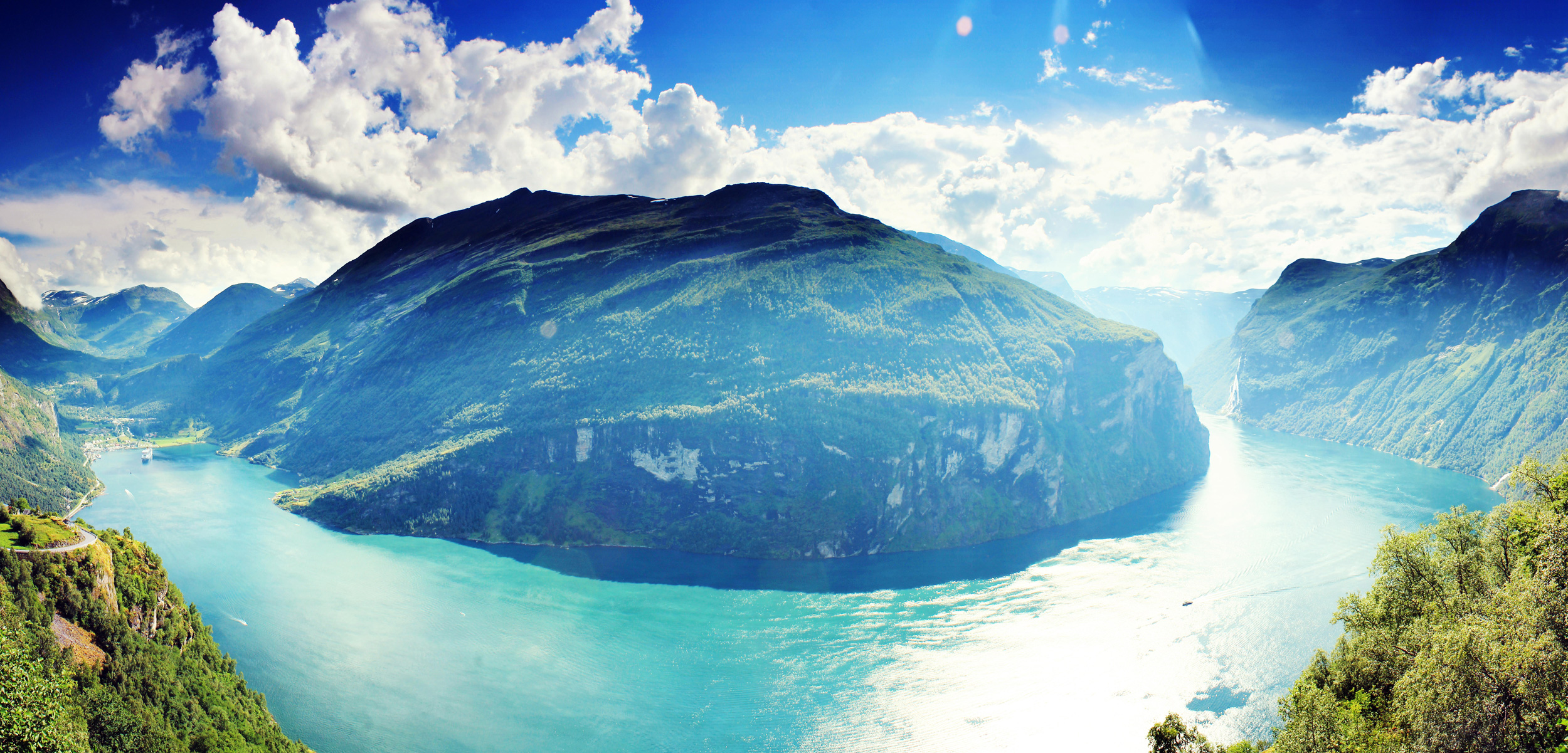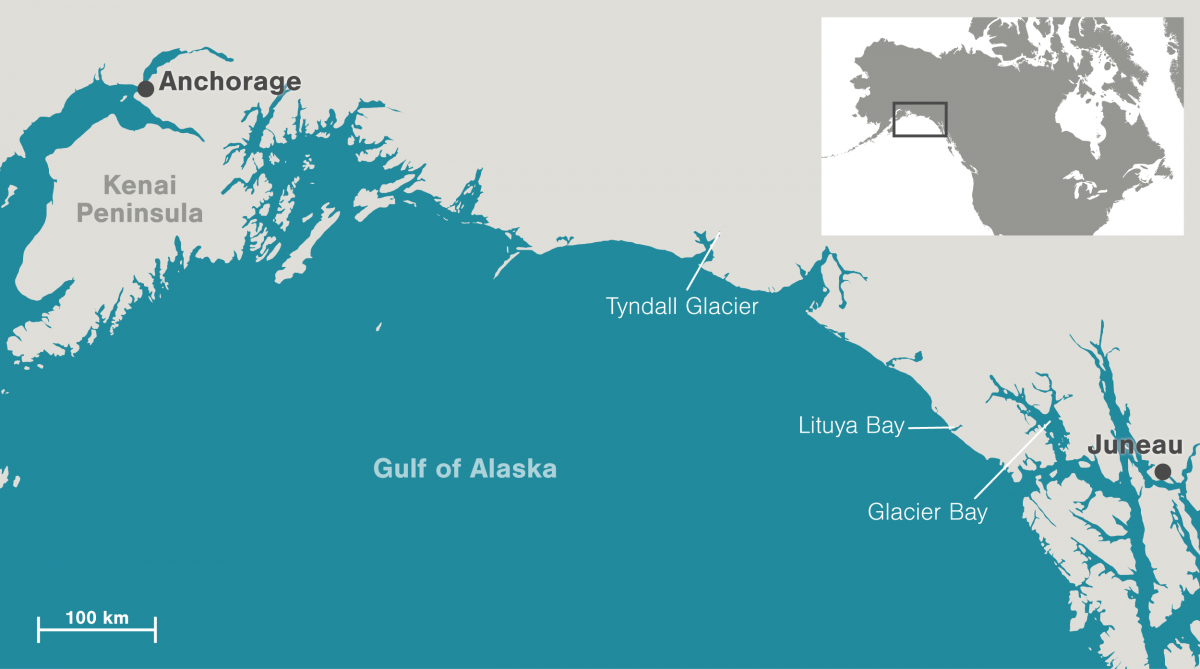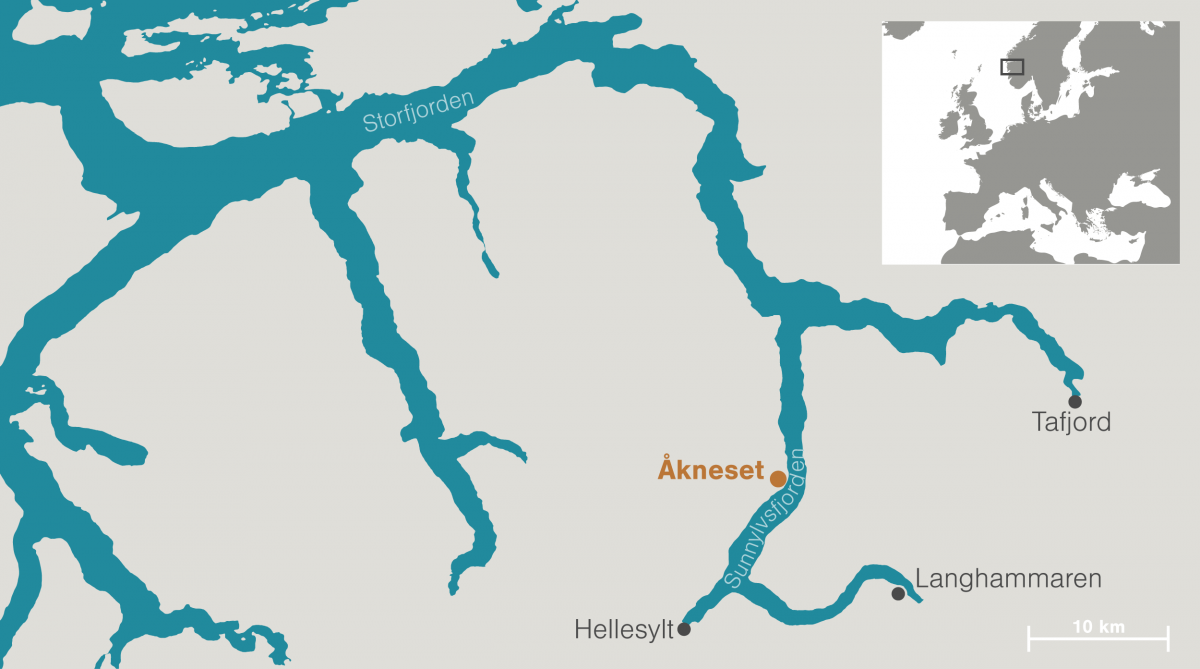When Mountains Fall into the Sea
As glaciers melt, unstable slopes are being exposed and are on the precipice of collapse.
Article body copy
Howard Ulrich and his eight-year-old son had just fallen asleep in their salmon troller when a sudden barrage of waves nearly knocked them out of their bunks. Their boat, the Edrie, was anchored in an uninhabited Alaskan inlet called Lituya Bay. Ulrich ran onto the jolting deck half dressed and heard a rumbling from the mountains at the head of the bay. His boy, Sonny, clambered onto the deck with him, and as the boat pitched and tugged at its anchor chain, they watched the 2,000-meter-high mountain peaks shudder and convulse, sending clouds of snow billowing into the air. Then it happened: “a mighty seismic disturbance … exploded with a deafening crash,” Ulrich recalled in an Alaska Sportsman magazine article. It was followed by a massive landslide.
The Ulrichs had anchored in the wrong place at the wrong time: ground zero for the strongest earthquake in Alaska in 60 years. It lasted over a minute, and the tremors were felt as far south as Seattle. The landslide it triggered was not a gradual tumbling of individual boulders. Rather, 82 million tonnes of rock and ice—the weight of 240 Empire State Buildings—hit the water as a slab. The impact was like an asteroid strike. Dropped from more than 900 meters, the slab sent up an instant, towering displacement wave that tore into the forested mountainside directly across the northern end of the inlet.
It was, and is, the largest wave ever recorded: 524 meters high. The initial splashdown kicked out a second, smaller, wave that sped across the inlet at over 150 kilometers per hour, shearing trees off the surrounding hills as it went. That wave was headed directly for the Edrie.
Ulrich shook off his awe, threw his son a life preserver, and told him to start praying. Though his anchor was stuck on the bottom—possibly pinned by newly shifted boulders—Ulrich managed to steer the boat toward the oncoming wall of water and climb it, snapping the anchor chain like fishing line as he did. The wave had reduced to about 20 meters high by the time it reached the Edrie, and after cresting it, Ulrich was able, barely, to ride out the ensuing chaos of refraction waves and log debris and exit the bay.
This animation shows the largest wave ever recorded, which was generated by a rockslide at the head of Lituya Bay in Alaska, followed by a surge of water that hurtled down the inlet. Video by Steven Ward/UCSC
Unbeknown to Ulrich, there were two other trollers in Lituya Bay on that July night in 1958. One, the Sunmore, was lost along with its two-person crew. The other, the Badger, had been anchored by owners Bill and Vivian Swanson on the opposite side of the inlet from the Edrie. The Swansons experienced what might have been the most bizarre phenomenon of the evening. As a United States Geological Survey (USGS) report put it, the speeding tsunami picked up their boat and carried it “stern first just below the crest of the wave, like a surfboard,” 25 meters above the treetops of a narrow spit at the mouth of the bay.
“We went away up over the trees,” Bill Swanson recalled to an Alaska Sportsman reporter, “and I looked down on rocks as big as an ordinary house as we crossed the spit. We were away up above them. It felt like we were in a tin can and somebody was shaking it.”
Lituya Bay is a glacial fjord on the Alaska Panhandle. From its narrow entrance to the opposing shore, the bay is 12 kilometers long, with two glacier-fed inlets emptying into it from either side. On a sunny summer day, it’s a Southeast Alaskan postcard: jagged peaks and snowfields at the head of the bay, a small island dotting the center, the waters an electric turquoise from runoff silt. But for boat captains, it has a reputation as a hazard—slack tide is usually the only time to avoid the breaking waves and sucking currents at the narrow entrance—and it possesses, obviously, other dangers. The bay is surrounded by mountain slopes that were buttressed by glaciers for thousands of years. Left exposed by retreating ice, they are now prone to landslides.
The potential for big rockslides is boosted by another aspect of Lituya Bay’s geology: the two riverlike glaciers at its head lie directly on top of the Fairweather Fault, a seismic rift where a massive continental tectonic plate meets a smaller, local plate. Evidence of landslide tsunamis there goes back to the mid-1800s.

In 1958 in Lituya Bay, a glacial fjord on the Alaska Panhandle, a rockslide kicked up a wave almost as tall as the CN Tower. Photo by Michele Cornelius/Alamy Stock Photo
On the west coast of North America there are other, older examples close at hand. Recent research in British Columbia has shown that the Da’naxda’xw First Nation village of Kwalate—with an estimated population of about 100 people—was wiped out by a huge displacement wave in the late 1500s when three to four million cubic meters of rock dropped into Knight Inlet.
Events like these are relatively rare, but climate change has ramped up the risks. As the world warms and glaciers disappear, more unstable slopes are being exposed. Alaska’s glaciers alone are losing 75 billion tonnes of ice—the weight of 14,000 Giza Pyramids—every year.
In Alaska in 2015, a mountainside collapsed onto the Tyndall Glacier, whose terminus extends onto tidewater. It was one of the largest landslides ever recorded in North America, more than double the size of the Lituya event—dropping as much as 540 Empire State Buildings worth of rock into the fjord and onto the glacier’s floating “toe.” The resulting wave surged 190 meters up the opposite hillside, stripping it bare of trees, and wreaked havoc as it roared down the 50-kilometer-long shoreline of surrounding Taan Fiord, tearing out vegetation and depositing massive boulders.
That fjord, like Lituya Bay, is uninhabited—at least by humans. In June 2017, a huge landslide-generated wave took a greater toll in the village of Nuugaatsiaq, Greenland. It washed away almost a dozen houses, leaving four people missing and presumed dead.
In Norway, the prospect of another major rockslide tsunami is not a question of if but when. The country has suffered several deadly ones in the past century; its national register of disaster scenarios puts a displacement wave in Storfjorden, the fjord area of the Sunnmøre region of southwestern Norway, in the country’s top five list of things to worry about. (Two of the others are a pandemic and a nuclear accident.) A Storfjorden tsunami even provided the basis for the 2015 Norwegian disaster movie The Wave.
Dan Shugar is an assistant professor of geoscience at the University of Washington Tacoma. He’s conducted research on landslides that has linked the Tyndall collapse to glacial retreat likely caused by climate change. In one 2018 paper, Shugar and his coauthors noted the worrying increase in landslides, citing the fact that there have been “at least eight large, long-runout landslides” in Alaska’s Glacier Bay National Park since 2012.
Shugar points out that most of Alaska’s unstable, rockslide-prone slopes are located in fjords that don’t have large communities in them. But some potentially hazardous fjords do have significant human habitation, he adds, and others are heavily populated in summer by tourists. The tidewater glaciers in Glacier Bay National Park—and in particular the Lamplugh Glacier, site of another huge 2016 landslide—are frequent destinations for large cruise ships. Some of the ships, like those run by Princess Cruises, can carry 2,500 passengers and over 1,000 crew members.
“I don’t want to be fearmongering here,” says Shugar, “but the potential for instantaneous destruction is pretty substantial.”
When a river carves out a valley over eons, Shugar explains, the land is characteristically shaped like a V in cross section. But glaciers have a different effect. “When they’re actively living, for lack of a better term, glaciers erode the valley walls they live between,” he says, “carving them into more of a U shape with steeper sides.”
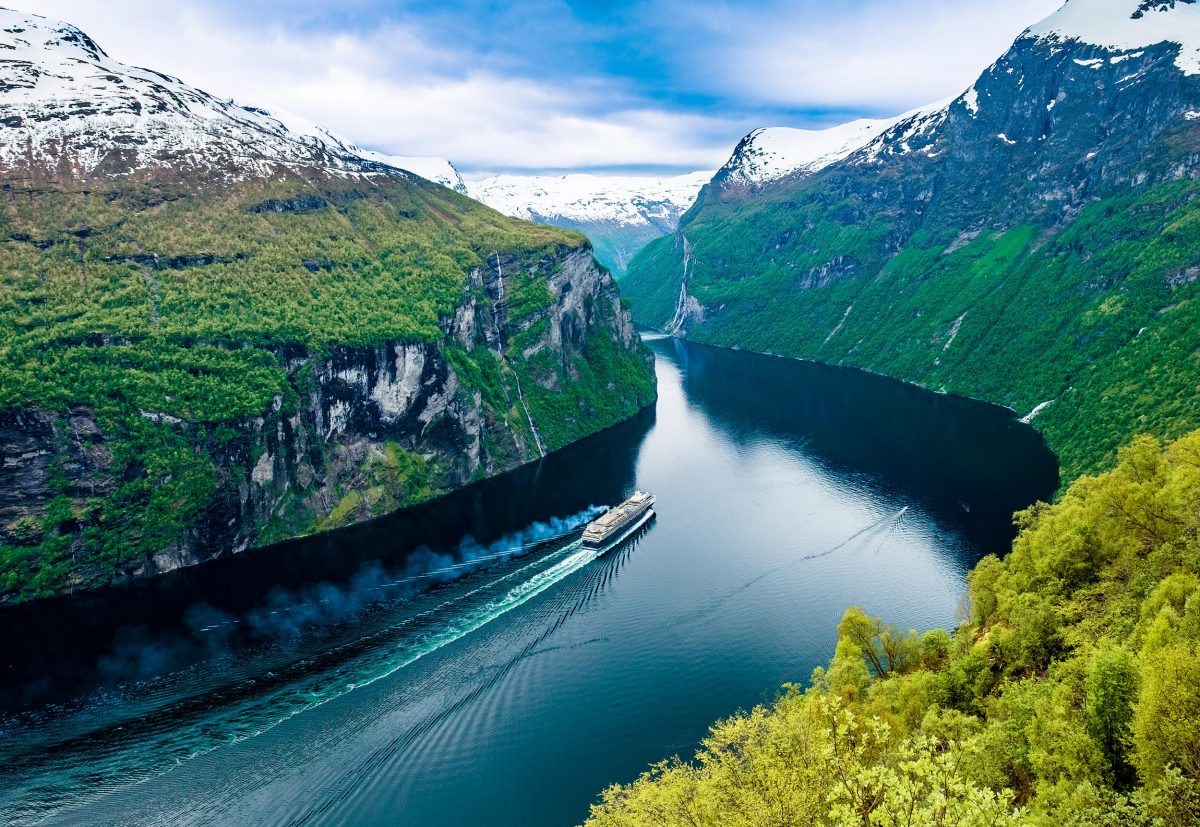
In Norway, rockslide tsunamis threaten to rearrange the topography and wipe out coastal villages. Photo by Andrey Armyagov/Alamy Stock Photo
As long as a glacier occupies a valley, it holds up the steep walls. But when the glacier begins to recede, or thins out, those walls are no longer supported, sometimes leading to major slope collapse. In some cases, the catastrophic failure of these mountainsides is preceded, says Shugar, “by decades, centuries, or even longer, of small, slow movements. The rock there might creep downwards only a couple centimeters, or only a couple of millimeters, per year,” he explains. “Then one day they just go—all of a sudden.”
For the people who live, work, or play in areas vulnerable to massive displacement waves caused by rockslides, research efforts boil down to two practical questions: can rockslide-induced waves be predicted? And can the people who find themselves, knowingly or unknowingly, in harm’s way—villagers, fishermen, tourists—be warned in time?
In Norway, rockslide tsunamis are imprinted in the national psyche. Three big ones struck there in the 20th century; the worst, a 63-meter wave that killed 40 people, hit the village of Tafjord in Storfjorden in 1934. The fact that climate change makes such disasters more likely is causing, in the words of one University of Oslo geologist, “an emerging state of unease” among Norwegians.
Storfjorden is one place for nervous Norwegians to avoid. It’s one of the longest and deepest fjords in the world, and one of its branches has been listed by UNESCO as a World Heritage Site for its archetypal fjord landscape. As a result, it’s a major cruise ship destination, with over 800,000 tourists visiting each year.
The downside of its attractive features—sheer mountainsides rising above sea level, blue waters nearly half a kilometer deep—is that they’re ideal for tsunamis. The main risk in Storfjorden is a mountain named Åkneset, which is expected to one day shrug off a massive amount of rock—about the weight of 225 Empire State Buildings—and produce a wave that would peak around 85 meters.
Åkneset, a mountain in Storfjorden, Norway, is expected to drop a significant amount of rock into the water and produce a wave nearly as tall as the Statue of Liberty. Video by Steven Ward/UCSC
Dealing with these realities in Storfjorden and elsewhere has made Norway a global leader in assessing and monitoring unstable slopes. (Switzerland, with more than half of its land base covered by the Alps, is another leading light in this area.) The Geological Survey of Norway (NGU) has been measuring movements in rock mass at Åkneset since the 1980s. In 2005, the NGU began mapping danger zones across the country with airborne laser scanning and other remote sensing techniques to create high-resolution topographic maps.
The array of technology now trained on Åkneset is impressive. Scientists periodically scan the mountain for deformations by ground-based radar, laser scanning, and satellite radar called InSAR. They monitor minute vertical and horizontal shifts in existing cracks and boreholes with fixed lasers and devices called extensometers.
“There are always movements going on,” says Thierry Oppikofer, a lead researcher with NGU who has worked on many scans of Norway’s unstable mountains. “On Åkneset, these movements can be from a few centimeters in the eastern part up to 10 or 15 centimeters in the west section.”
Monitoring is not merely a research exercise; it’s primarily a safety measure. While rockslides can happen suddenly and without warning—especially in earthquake-prone areas like Alaska—many experts believe they can be predicted. When not triggered by a seismic event, an unstable slope will give notice that it is about to let go, says Oppikofer. The catch is that you have to be watching for it, using the types of rather expensive technology that Norway and Switzerland have perfected.
“Slides are always happening in slow motion, and these movements go faster before a major slide. This has been seen in several past events,” Oppikofer says. Tracking movement rates can give authorities up to three days’ warning. That’s 72 hours to evacuate the local population, and, in a place like Storfjorden, to tell all the cruise ships to turn the hell around and hit the throttle.
Oppikofer notes that in at least one regard Norway is lucky: it has few earthquakes. Western Europe’s seismic events cluster around the Mediterranean, and in mainland Norway there has never been a recorded earthquake that has registered above magnitude 6 on the Richter scale.
When the time comes to warn people, Norway has other groundbreaking tech: a cellphone alert system. In the event that slope movement at Åkneset starts to accelerate and authorities believe a slide is imminent, the alert system will detect all nearby cellphones, as well as their country of origin, and send a message—essentially, “Run!”—in Norwegian, English, or German.
While Norway has spent the past dozen years mapping its landslide hazards, creating a risk classification system, and installing monitoring and warning systems in several locations across the country, the picture in Alaska is very different. Despite significant deglacierization and a related spike in huge landslides—many near or within the bounds of heavily touristed areas like Glacier Bay National Park—the US federal government hasn’t funded anything similar for the area.
“Up to this point, the USGS hasn’t done monitoring or assessment in Alaska in any systematic way,” says Jeff Coe, a research geologist at the USGS’s Geologic Hazards Science Center.
Coe notes one exception: in the early 2000s, the agency identified a potential landslide at Tidal Inlet in Glacier Bay National Park and predicted a significant wave if the slope lets go. The researchers stated in a 2007 paper that the wave would be significantly smaller than the one that occurred in 1958 in Lituya Bay, but that it posed a “very high” risk due to the cruise ships that pass Tidal Inlet throughout the summer months.
Despite the potential danger, there has been little follow-up by the USGS. It’s not something that the organization currently does, Coe says, adding that any assessments or monitoring programs would be initiated by individual parks, towns, cities, or states.
“The awareness of the slides that have been happening in Alaska, that’s growing every year,” says Coe. The recent Greenland tsunami and other rockslides in northern regions in the past few years are creating “a rising awareness that this is something that we need to address as a community,” he adds. But so far that recognition hasn’t added up to anything concrete.
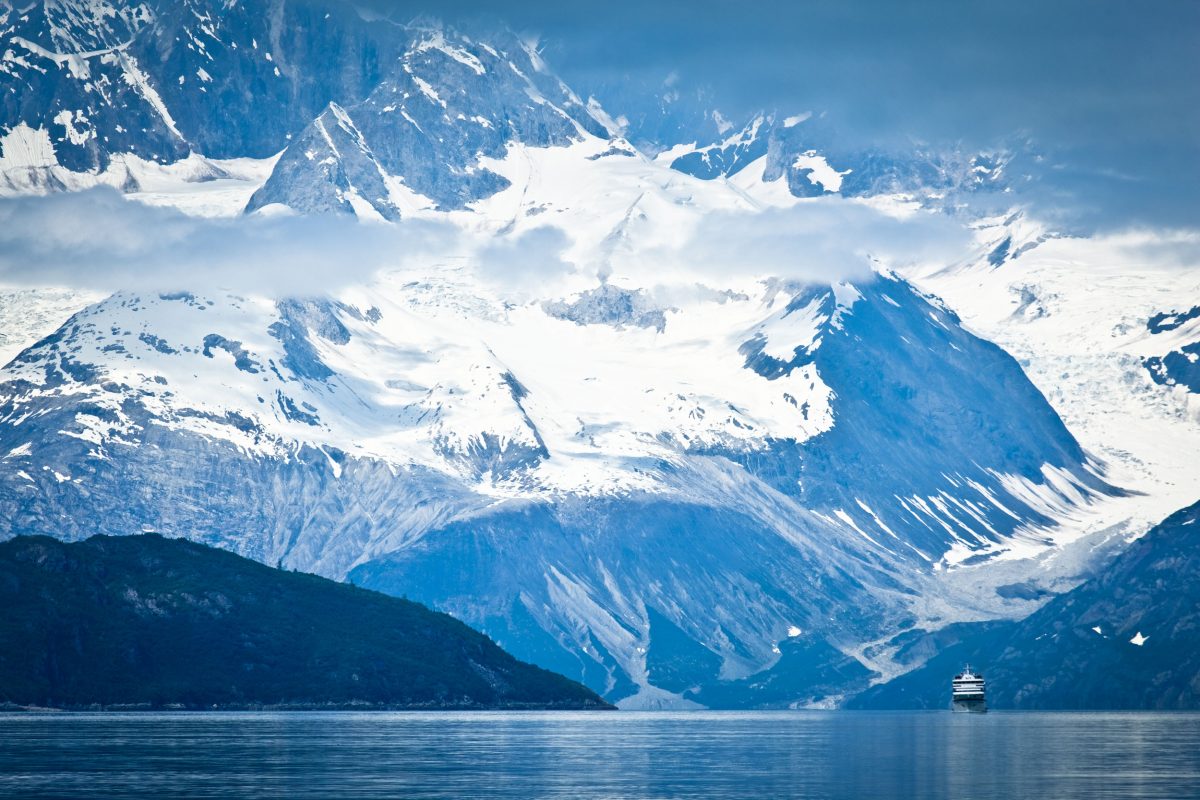
Cruise ships, like this one making its way through Alaska’s Tarr Inlet, could be destroyed by a landslide-induced wave. Photo by Design Pics Inc/Alamy Stock Photo
Gabriel Wolken is a research scientist and manager of the Climate and Cryosphere Hazards Program at Alaska’s Division of Geological and Geophysical Surveys. He’s the coauthor of a November 2017 paper warning that many of Alaska’s formerly glacier-filled valleys are now dangerously unstable.
Wolken says that the risks posed by landslide tsunamis in Alaska are “low potential, but high cost,” and that he agrees “completely” with Dan Shugar’s assessment of possible catastrophes. “The Lamplugh Glacier avalanche, which was the largest rock, snow, and ice avalanche in the world in 2016, would have completely destroyed any cruise ship in Glacier Bay if it had hit the water,” he says. “That also goes for the Tyndall event as well if there had been a cruise ship near it.”
But Glacier Bay, says Wolken, is not the only risk zone. The same rock type that is in the national park area extends all the way over to the Kenai Peninsula, he says, and it has the same instabilities. “There’s no reason landslides can’t happen in the other areas in Alaska, areas where we have critical infrastructure and where people and property exist. It’s really an important issue.”
Unfortunately, the State of Alaska has yet to assess any of these hazards. There are two reasons for this, according to Wolken. First is the state’s size, which is more than 4.5 times that of Norway. The second is a lack of research dollars. While there are limited resources available to study avalanches and rockslide tsunamis after they occur, says Wolken, there is even less available to investigate the hazards of at-risk slopes.
“A broad-scale assessment of unstable slopes has not been done, and it desperately needs to be done,” he says. “What I would like to see is for this to be taken to another level, which means to assess the dangers ahead of time instead of just responding to events after the fact. If we can do that, then we can really start to save lives, critical infrastructure, and money.”
Climate change has put policymakers and hazard planners on their back foot in the past 10 years. The world is facing a laundry list of disaster scenarios: sea level rise, high-intensity hurricanes, wildfires, and the kind of apocalyptic water shortages currently unfolding in South Africa. In this context, rockslide tsunamis start to sound like an outlier on which it’s not worth spending already scarce public resources.
Whether the next tsunami disaster on the West Coast is more likely to hit a fishing boat of two people, a village of 100, or a cruise ship of 3,500 is impossible to say. There seems to be only two ways of dealing with the problem: monitor at-risk slopes like Norway, or create no-go zones in these areas and either wait for, or induce, slides. The second option means some people would have to move and cruise ships and other tourism operations would be robbed of their scenic cash cows. But the cost of doing nothing at all could turn out to be incalculable.

